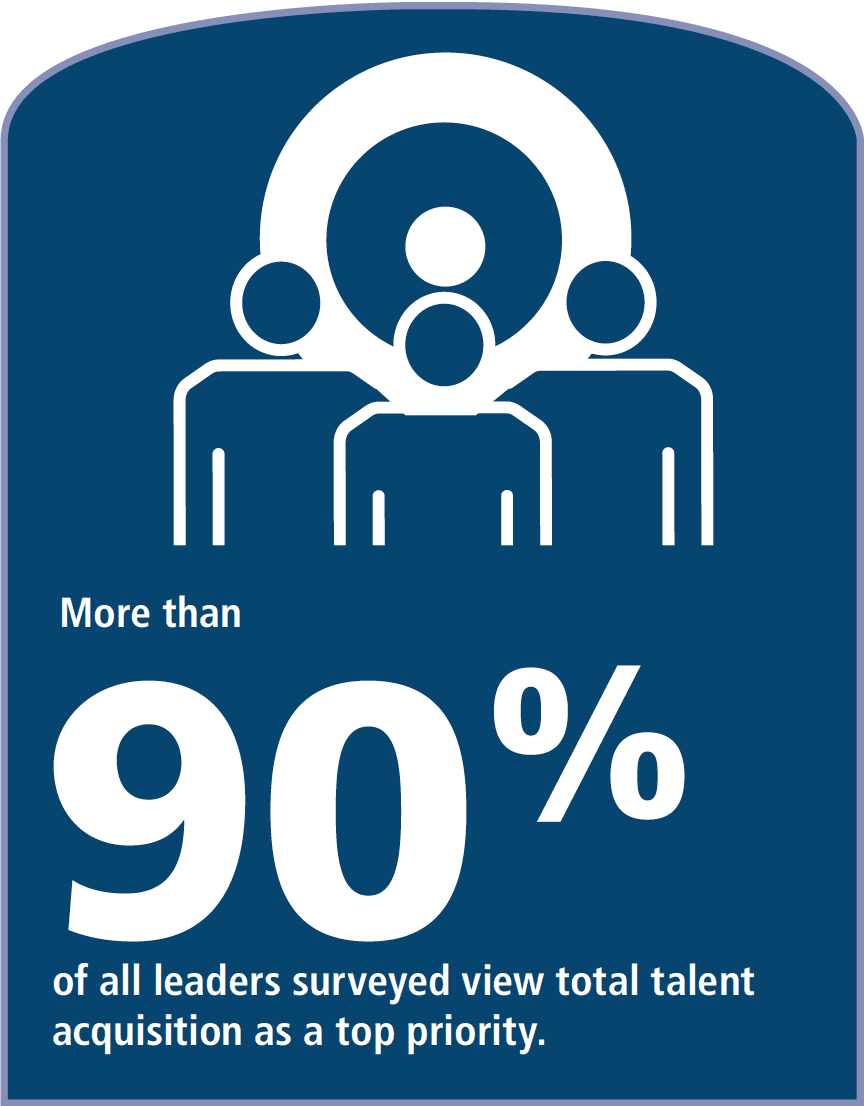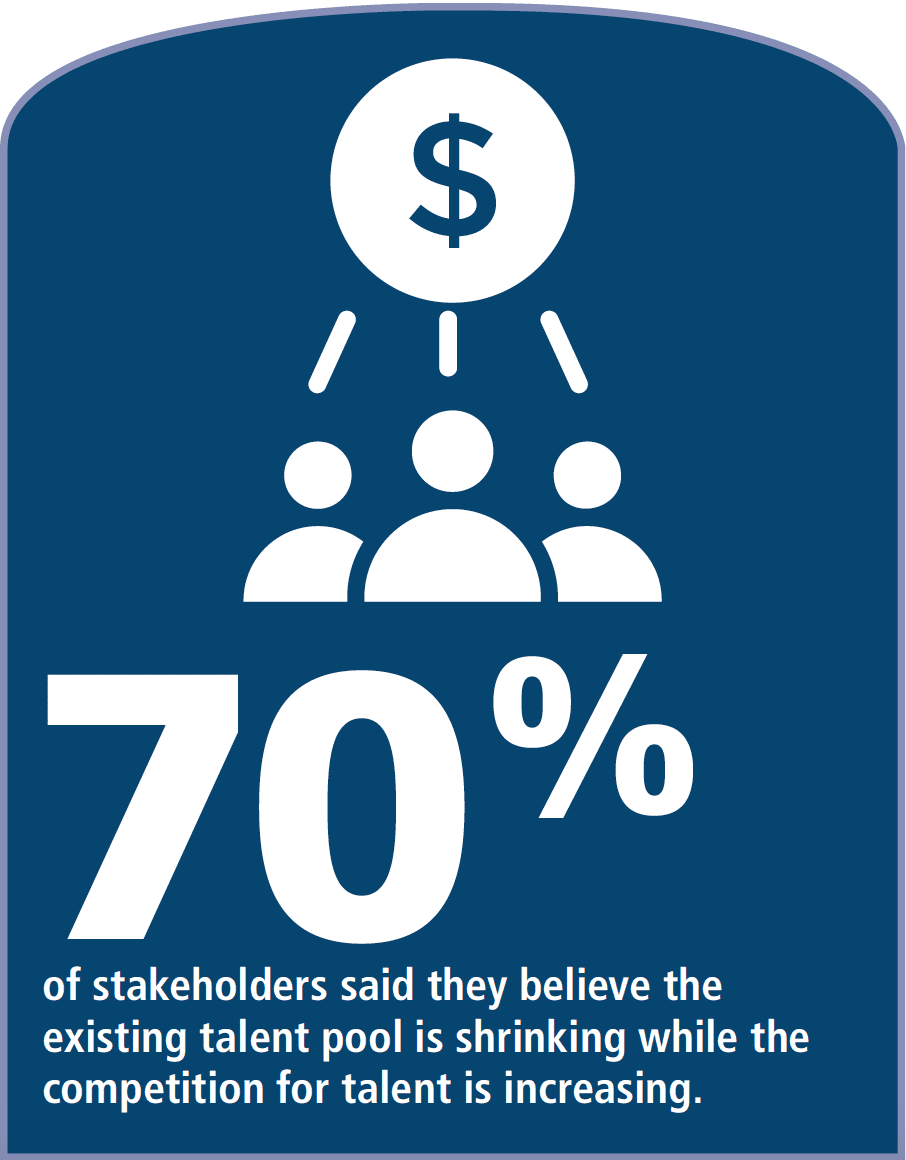Companies are shifting their talent acquisition strategies to succeed in a candidate-driven market.
By Marissa Geist
In a stark reminder of how challenging today’s talent shortages have become, 54 percent of business leaders in Cielo’s recent Talent Acquisition 360 study said their companies have more open positions than ever before. Nearly 70 percent of stakeholders said they believe the existing talent pool is shrinking while the competition for talent is increasing. This battle of supply and demand is causing C-Suite leaders to include talent acquisition and retention as a critical component of their overall business strategies to ensure organizational performance is not hampered by talent gaps.
Five other key talents trends were also identified in the research, including:
1. Contingent workers are taking over full-time roles. Contingent labor -including temporary staff, consultants, independent contractors, interim executives, and gig workers -is a growing portion of the workforce at every level. Nearly 30 percent of the 1,100 stakeholders surveyed are now hiring contingent workers across all job levels of the organization.
This includes an average of 24 percent of senior leadership roles, 28 percent of manager-level roles, 32 percent of individual contributors, and 41 percent of entry-level talent. For example, a company may have consultants handling outsourced management-level projects, gig workers driving trucks, temporary staff filling roles throughout the office and factory, and a few interim executives overseeing key leadership roles while the company is recruiting for replacements.
Even more, 65 percent of business leaders surveyed said this trend toward a greater proportion of contingent workers will grow in the future, as they expect temp labor to take over a significant amount of the work currently being done by full-time employees. This may reflect, in part, workers’ desires to have more flexible work options in combination with employers’ needs to fill roles temporarily due to the difficulty of finding qualified full-time staff.
This candidate market is prompting change on a large scale, challenging the way companies think of engaging talent outside of full-time roles as many employers are faced with the reality that some of their top talent may never be direct employees.
 2. Total talent acquisition approaches will rise. Because of the reliance on contingent staff for nearly one-third of the organization’s talent resources, total talent acquisition -a consistent and comprehensive approach to both full-time and contingent talent acquisition -has emerged as the next big thing business leaders are targeting. More than 90 percent of all surveyed leaders view total talent acquisition as a top priority, especially those in the healthcare, retail, consumer goods, and automotive industries. In the United States, 100 percent of survey respondents said total talent acquisition is a top priority. This is in stark contrast to Cielo’s 2015 study, in which a total talent approach was merely a future goal.
2. Total talent acquisition approaches will rise. Because of the reliance on contingent staff for nearly one-third of the organization’s talent resources, total talent acquisition -a consistent and comprehensive approach to both full-time and contingent talent acquisition -has emerged as the next big thing business leaders are targeting. More than 90 percent of all surveyed leaders view total talent acquisition as a top priority, especially those in the healthcare, retail, consumer goods, and automotive industries. In the United States, 100 percent of survey respondents said total talent acquisition is a top priority. This is in stark contrast to Cielo’s 2015 study, in which a total talent approach was merely a future goal.
Although all stakeholders agree that total talent acquisition is a top priority, 68 percent of HR leaders believe it is their responsibility while 65 percent of procurement leaders think it is a role they own. Only a quarter of HR and procurement leaders believe that total talent acquisition is a shared responsibility.
Companies recognize the need for a more consistent approach to how they attract and recruit both full-time employees and contingent staff. For instance, 66 percent of survey respondents said they are using different providers to recruit each group. A total talent approach would provide a more complete view of the workforce to help make better decisions for the future.
In that vein, 55 percent of respondents said they plan to invest in an outsourced talent acquisition partner in the next year.
3. More organizations will leverage recruitment process outsourcing (RPO). Forty percent of all stakeholders surveyed are already using an RPO partner and another 23 percent of companies are planning to hire one in the next year. This increase in intended RPO utilization is unsurprising given the increased severity of talent shortages and the focus shifting to total talent acquisition.
The survey found that top-performing companies, defined as those retaining 80 percent of their top talent and having 80 percent of employees meeting their performance goals, are twice as likely to be outsourcing the recruitment process. These high performers also report significantly higher satisfaction with the efficiency of the talent acquisition process, the candidate experience, and the scalability of their talent acquisition program.
RPO is more prevalent in the healthcare, retail, and consumer goods industries, and is used by 50 percent of companies with more than 10,000 employees, according to the study.
4. Now is the time to align talent strategy with business strategy. More than 70 percent of C-Suite leaders report they want to play a role in talent acquisition decisions, a clear indication of the increasing pressure to align talent acquisition and retention with business objectives. However, the study showed a clear lack of consistency in how to accomplish this alignment.
 Leaders in all of the business roles and functions surveyed -C-Suite, HR, procurement, and business operations -agree that talent is a core business driver, but they disagree on talent acquisition priorities, effectiveness, and metrics for success. While HR and business leaders are now much more aligned than in Cielo’s 2015 study, there is still a need for improvement across the organization.
Leaders in all of the business roles and functions surveyed -C-Suite, HR, procurement, and business operations -agree that talent is a core business driver, but they disagree on talent acquisition priorities, effectiveness, and metrics for success. While HR and business leaders are now much more aligned than in Cielo’s 2015 study, there is still a need for improvement across the organization.
For example, procurement leaders rated hiring manager satisfaction as their top success metric, while HR, business operations, and the C-Suite rated quality of hire as the most important metric. And while all stakeholders are generally optimistic about the effectiveness of their organization’s talent acquisition efforts, the C-Suite was two times more likely than business leaders to think their talent acquisition program is highly effective.
5. The use of technology and data have improved, but there’s room for more. In the 2015 study, companies were challenged with technology implementation across the organization, but today only 10 percent of companies identified new technology implementation as a priority, often relying on partners for this role. Instead, stakeholders are more focused on finding technology that will provide a positive candidate experience. Basic uses of technology such as background screening and assessments are viewed as the most effective for the organization.
As companies become more comfortable with data and its importance in talent acquisition, analytics are increasing in relevance. Stakeholders were nearly three times more likely to praise the use of data to diagnose problems today than in 2015.
The study revealed a stunning gap in the effectiveness of candidate-facing technology and processes, with nearly half of the 200 active job seekers surveyed stating that they only hear from employers “sometimes” after they submit an application. Only 1 percent of candidates have communicated with a recruiter through text, revealing an over-reliance by organizations on email as their primary form of communication. Considering that 33 percent of candidates said they are applying for jobs using mobile devices, a shift toward candidate experience technologies that incorporate text, video, and other modern forms of communications would likely increase effectiveness.
Opportunities to improve talent acquisition begin with better collaboration and communication across the enterprise to guide alignment with business priorities and ensure a single, consistent strategy. A consistent approach for attracting, recruiting, hiring, and retaining all types of talent -from contractors to permanent employees -will also be key to maintaining workforce productivity as a candidate’s market continues to thrive. Organizations also need to improve communication and engagement with candidates throughout the talent acquisition process or risk losing them to their competitors.
Marissa Geist is executive vice president and managing director of the Americas for Cielo.














